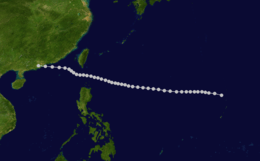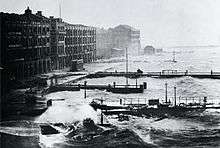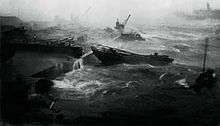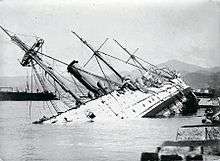1906 Hong Kong typhoon
 Track of the typhoon | |
| Formed | 7 September 1906 |
|---|---|
| Dissipated | 18 September 1906 |
| Lowest pressure |
984 hPa (mbar); 29.06 inHg ([lower-roman 1]) |
| Fatalities | 4000 ‒10 000 (estimated) |
| Areas affected | Qing China (especially British Hong Kong) |
| Part of the 1906 Pacific typhoon season | |
The 1906 Hong Kong typhoon was a tropical cyclone which hit the city of Hong Kong on 18 September 1906. The event was a major natural disaster, property damage exceeding a million pounds sterling and affecting international trade,[1] and loss of life that amounted to around 5% of the contemporary Hong Kong population.[2]
Meteorological history
The Hong Kong Observatory recorded the 1906 typhoon as having a velocity of 24 miles per hour (39 km/h) when the eye of the typhoon was 30 nautical miles (56 km) distant and it had a wind force of 6 Bft taken as limit, about 100 miles (160 km; 100 mi) miles in diameter. The Hong Kong Observatory had recorded the 1896 typhoon (29 July) with a velocity of 108 miles per hour (174 km/h) when the eye of the typhoon was of 47 nautical miles (87 km; 54 mi) distant, and with a wind force 6 taken as limit, about 500 miles (800 km) in diameter.[3]
Preparations

The Hong Kong Observatory was said to give less than 30 minutes' alert of a rapidly approaching typhoon; by then it was close to Hong Kong waters. A black drum (an official warning to be issued for tropical cyclones from Hong Kong Observatory since 1884) was hoisted at 8:40 AM, before the typhoon gun was fired for its harbor warning. By 9:00 AM, the ferries had already ceased to operate and quite a few of the foreign steamer captains and their sailors were caught off-guard and stuck on land, unable to quickly reach their vessels to take any necessary precautions. The barometer showed a rapid drop from 29.74 inHg to 29.28 inHg between 8:00 AM and 10:00 AM, within just two hours.[4]
There were two reports from Shanghai observatory regarding an advance warning of the 1906 typhoon:
- Japanese observation from east of Formosa (Taiwan) was said to have given the first warning of calamity by telegraph, calling 'Typhoon South of Meiaco Sima (Chinese: 釣魚台列島)'. It was dated 15 September 1906 (Saturday 11:30 AM), three days in advance, moving towards the direction of Taiwan or China.
- Sicawei Observatory (Chinese: 徐家匯) in Shanghai further reported and based on extracts from logs of ship vessels, about a definitive track of the storm on 15 September (Saturday) and 16 September (Sunday) from the regions of Pacific Ocean and Taiwan, and the track was on 18 September (Tuesday). The 1906 typhoon formed in the southern part near Bashi Channel (Chinese: 巴士海峽) from WNW or WbN, at a distance 420 miles from the China Sea.
Impact
During the high time within 2 hours, much property damage occurred to the housing properties on the land and the shipping vessels in the port, and an estimated 4000–10 000 lives might have been lost in the Colony.[4]
Hong Kong

The wind howled, the broken glasses and rustling roof tiles were thrown everywhere. Tree branches were torn and some trees were even unrooted. The passers-by, rickshaw coolies and sedan chairs carriers were rushing through along the streets, and some were even blown off their feet by the strong gales. The tram lines on Hong Kong Island stopped operation when some of its electric wiring bars, being hampered by falling pipes and their tracks, were obstructed by roadside debis. The Peak Tram's service was also discontinued for 2 hours after 10 AM, after its signalling cables, being damaged by broken tree branches and some landslides, covered its track along Bowen Road. The Botanical Gardens had their trees and flowering plants broken down while the glass house and the zoological department were intact among the terrible havoc.[4]
At West Point many warehouses, including those from Jardine, Matheson & Co. and Jebsen & Co. were unroofed and their main door and front walls were totally stripped out. The matshed roof covering from Blake Pier, Queen's Statue Wharf and Star Ferry Wharf in the Central District collapsed like houses of playing cards. The bamboo scaffolding structure for the then-new General Post Office could not withstand the strong winds, which blasted its debris on to Pedder Street and completely crashed to block the approaching road nearby. Similarly, the then-new Supreme court building also had its site erection suffering from a destructive blow for its structure.[4]
Offshore incidents

Along the praya from West Point (Sai Wan) to East Point (Causeway Bay), many sampans and lighters were damaged and broken down into pieces, the sea passage was obstructed by the floating objects from boat wreckage. Within 2 hours of the typhoon strike, some European and Chinese bystanders braved their lives to rescue more than 700 unfortunate people fallen from the boat capsized at Wan Chai and East Point (Causeway Bay) areas. From the Kowloon Wharf, the Docks to Sham Shui Po waterfront, sampans and cargoes could not escape the damage and destruction, scattering down the praya. There were heavy casualties in shipwrecks near Kowloon Star Ferry Wharf, such as from two river steamers of Kwangchow and Hong Kong, both sunk in the storm with crews and passengers aboard, causing the loss of 300–400 lives. The Wingchai ferry, heading for Macao with 200 passengers on board, was driven back by the typhoon and took refuge at Stonecutters Islands and later drifted to the rocks; about twenty of those died.[4]
A few local steamers were sunk outside the Hong Kong harbour. The Mirs Bay ferry (Albatross) sank near the Ninepin islands, with 120 passengers dead. The Sam-chun ferry (Ying Fat) sank near Capsuimoon, with 100 passengers dead. A Macao steamer, the Heungshan, drifted to Sau-chau, near Lantau Island with 500 passengers on board, and was only rescued the next day, with a few casualties. Another Macao steamer, the Kinshan was grounded ashore near Castle Peak. A third Macao steamer, the Perseverance, having discharged all its passengers at Chung Chow, sank upon its return and only one crew survived.[4]
It was roughly estimated that nearly half of the Chinese boating population and their 5 000 licensed watercrafts in the Colony were struck in this natural disaster. Many people living in houseboats with their families in fishing villages along the coast were mostly affected. Once the typhoon abated, the police and military rescues were in full swing, turning over the ship wrecks, searching for the injured and retrieving the dead for burial. The Tung Wah Group of Hospitals, a charitable organization, donated coffins for the burial of the corpses uncovered from the ruins and shipwrecks. The job of burial was tough even for experienced sanitary coolies, as the unclaimed bodies were said to number more than 1 500 (including those mutilated ones) by the end of September 1906.[4]
Aftermath

Sir Matthew Nathan, then Governor of Hong Kong, expressed his sympathy and the condolences of the King. The governor praised the heroic and selfless deeds from many European and Chinese citizens to perform life-saving rescues, and agreed to set up a committee to develop an early warning system to be in place for the Hong Kong Observatory for future typhoon alerts. The governor reported that they had received emergency relief funds from overseas Chinese in San Francisco of HK$10 000 (just recovering from their own earthquakes in April 1906) and local Chinese donations of HK$80 000 within just a few days of the calamity, among many others, from the efforts of the Tung Wah Hospitals Group, Po Leung Kuk, and the District Watchmen Committee.[4] Initial contemporary reports estimated a loss of life of 'about 10,000',[5] and later reports suggest it was 16 000, or '5% of the 320,000-strong population in Hong Kong at that time'[2]
The British military authority approved a team of 150 people to help the colonial government clear up the wreckage in the port. Meanwhile, the 1906 typhoon had exerted a great blow and serious delay to the Hong Kong cargo shipping business, as many lighters and sampans were broken up (possibly up to 80%) and the wharf and warehouse facilities damaged, suffering from a million dollar loss.[4]
A report of committee appointed to enquire whether earlier warning of the typhoon of 18 September 1906 could have been given to shipping was chaired by Sir Henry Spencer Berkeley, KC (Hong Kong Attorney General of 1902 ‒06) and together with three more members (Lieutenant Butterworth of the Royal Navy, Mr Skottowe of Eastern Extension Telegraph Co., and Captain Sommerville, Steamship Master of SS Tean), they met and gave their findings to the Hong Kong Governor on 23 October 1906. The committee reviewed the conflicting evidence, and reported that they did not find any indication of a typhoon approaching Hong Kong before 7.44 AM on 18 September (Tuesday morning), and that warning by the hoisting of the Black Drum (indicating an existence of a typhoon to the east of the Hong Kong within 300 miles) on the Tuesday morning was performed as soon as possible.[6]
Notes
- ↑ Minimum pressure is only representative of observed values in Hong Kong; the storm was likely strong while over open water earlier in its track.
References
- ↑ "Hong Kong Typhoon". New Zealand Herald. XLIII (13324). Auckland, New Zealand. 2 November 1906. p. 4. Retrieved 13 July 2013.
- 1 2 Ho, Pu-yin (2003). Weathering the Storm (PDF). Aberdeen, Hong Kong: Hong Kong University Press. p. 76. ISBN 962 209 701 4.
- ↑ Gibbs, Lawrence (October 1908). "The Hong Kong Typhoon, September 18, 1906". Quarterly Journal of the Royal Meteorological Society. 34 (148): 293–299. Bibcode:1908QJRMS..34..293G. doi:10.1002/qj.49703414808.
- 1 2 3 4 5 6 7 8 9 "The Calamitous typhoon at Hong Kong, 18th September, 1906" (PDF). Hong Kong Daily Press. University of Hong Kong Library. 1906. Retrieved 23 June 2013.
- ↑ "Hong Kong Typhoon". The Brisbane Courier. Brisbane, Australia. 11 October 1906. p. 4. Retrieved 13 July 2013.
- ↑ Berkeley, Henry S; Butterworth, H; Skottowe, A B; Sommerville, A. (1907). "Report of Committee Appointed to Enquire Whether Earlier Warning of the Typhoon of September 18th, 1906, Could Have Been Given to Shipping" (PDF).
External links
- Photo album from the British Army’s Royal Army Medical Corps
- Gwulo: Old Hong Kong
- Images from the State Library of Victoria